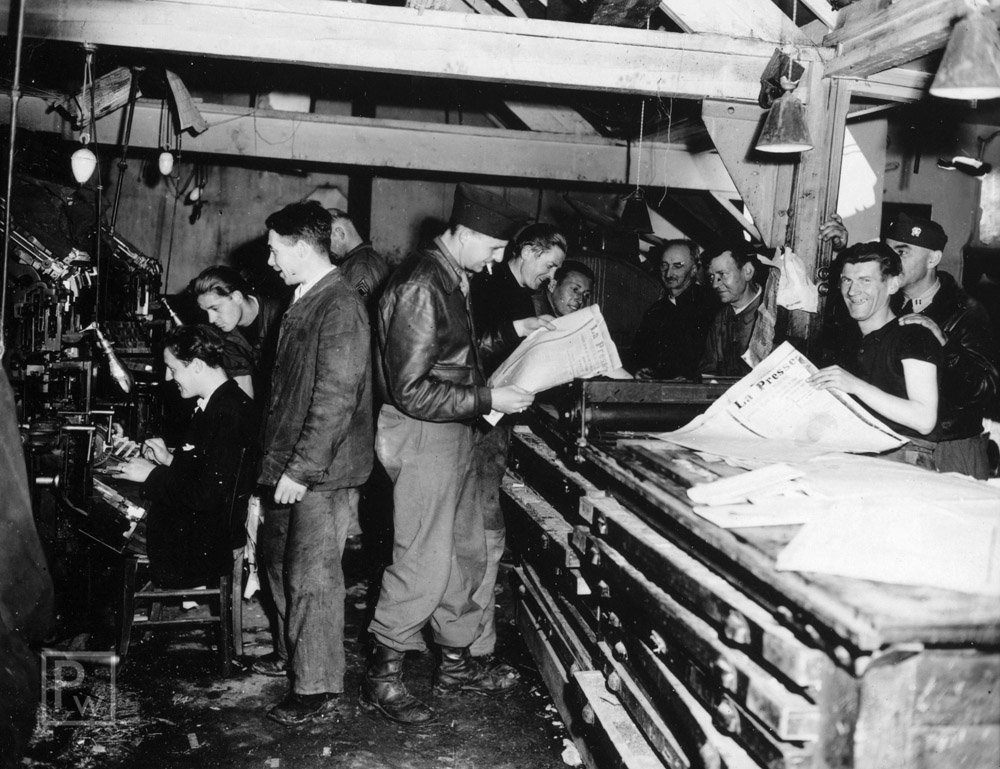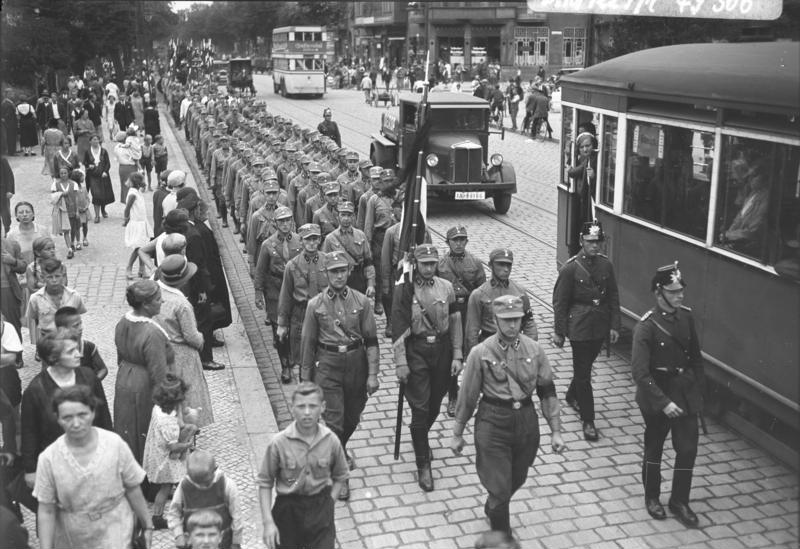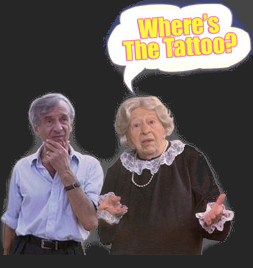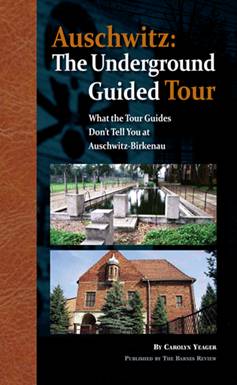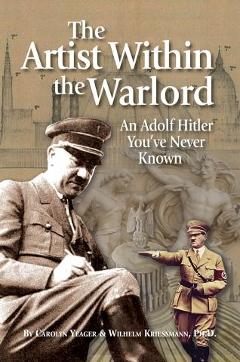Psychological warfare operations explain the 'Kristallnacht' action
Psychological Warfare Division personnel looking over their work output and appearing quite happy with it. In fact, a certain lack of seriousness, even hilarity, pervaded these well-financed efforts, which we can more easily recognize today for what they are.
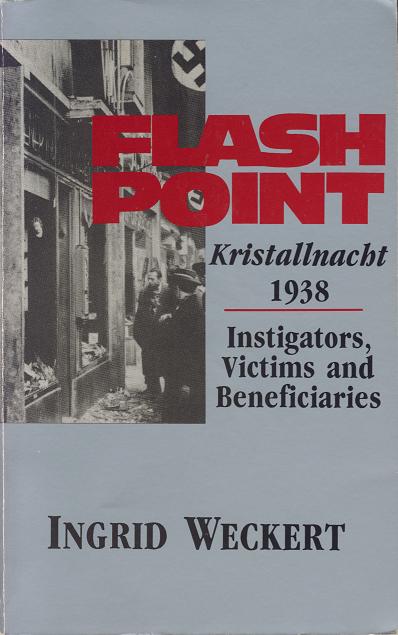 FLASHPOINT Kristallnacht 1938: Instigators, Victims and Beneficiaries by Ingrid Weckert
FLASHPOINT Kristallnacht 1938: Instigators, Victims and Beneficiaries by Ingrid Weckert
Translated by Mr. Carl Hottelet from the original German
English translation Copyright 1991 by Institute for Historical Review in arrangement with Grabert Verlag, Tübingen, Germany
By Carolyn Yeager
Part Six
“Mueller Telex” and other fake documents
WE'VE NOW GOTTEN TO THE "FORGERY FACTORY," as Ingrid Weckert calls it (and she isn't the only one who has). She informs us in Chapter 15 that a third version of the "Heydrich telex" is presented, this time at the IMT, and numbered together with other documents to which it seems to have little in common.
This particular telex message is from Gestapo Mueller (SS-Standartenfuehrer Heinrich Mueller) in Berlin. It was sent out at 11:55 pm on Nov. 9, almost one and a half hours before the Heydrich message went out. It was addressed to All State Police offices and All State Police agencies, announcing [in my shorthand form -cy] that:
-
Action against Jews, particularly against their synagogues … will take place in a very short time and are not to be hindered.
-
Valuable archival material found in synagogues should be immediately secured.
-
20-30,000 'wealthy' Jews are to be arrested. More precise directives to be issued.
-
Weapons found in the possession of Jews are to be taken.
Addendum for State Police Cologne: The Cologne synagogue has especially important material that is to be secured by speediest measures in cooperation with Security Service.
Signed Gestapo II Mueller
This telex is secret
Weckert says it's written in a “peculiar German of convoluted syntax and bloated verbiage.” She goes through a long list of “conspicuous stylistic monstrosities” and bureacratic nonsense. She remarks that Heinrich Mueller had absolutely no command authority over “all State Police agencies (unlike Heydrich); that Mueller does not refer to an order by the Reichsfuehrer-SS as authority but acts on his own; that there were three synagogues in Cologne, not “a” synagogue; and that no such German telex message "that looked like this one" has ever been found. This “Mueller telex message” is printed on pp. 377/378 of IMT Volume XXV where it is part of American prosecution document 374-PS. [And copied in part on pgs. 80-81 in Flashpoint -cy]
She continues with a further scathing indictment of this document 374-PS and what it includes. One of its four individual documents is headed “Supreme Headquarters, Allied Expeditionary Forces, Psychological Warfare Division (PWD), Intelligence Section.” Disseminated by PWD 14 May 1945, released by SHAEF.
The PWD was known to be engaged in the production of fake reports, spurious documents, falsified presentations of actual occurrences, and lies in general. It's wartime assignment was to undermine the morale of the enemy, shake their confidence in their leadership, and/or incite them to resistance against their government [an example being the White Rose Society -cy]. It was to a leading member of the PWD that Prof. Dr. Friedrich Grimm suggested after the armistice in May 1945 that it was time to stop the hate propaganda against Germany. He was told:
No! We are just beginning! We shall continue the atrocity propaganda, we shall intensify it, until no one has a good word to say about the Germans, until all the sympathy you have enjoyed in other countries is destroyed, until the Germans are so addled that they no longer know what they are doing.” (Grimm, Politische Justiz, p. 148) (p. 84)
Another of the exhibits of 374-PS is a circular letter of the NSDAP Koblenz/Trier region of June 7, 1933, easily recognizable as a product of that center of forgery. It is addressed to all District Administrations of the Koblenz-Trier Region. It's fairly long so I'll briefly summarize it. The subject is “List M-18 Fight Against Jews No. 2.” It asks recipients to report the names of Party members and other Germans who purchase things from Jews.[...] the committees are to “secure salesladies from Jewish stores who can then very easily name the people who buy in Jewish businesses.” This “securing” is to take place in “extreme secrecy.” […] in membership and public meetings, they are to “call attention to the fact that the Jew in all countries once again has started a very dirty fight that damages Germany tremendously.” […] “It must come so far that it is expressly to be indicated that no German, if it does not somehow have to be, speaks with a Jew.” Signed “Bang, Regional Propaganda Director”
Weckert calls this gibberish that she couldn't decide to be outraged or to laugh at. She informs us that the Koblenz-Trier regional propaganda director from 1932-37 was named Willi Michels, but a member named Bang was director of the German Labor Front. A careless error. She also writes about the “Brown Books” put together during those years by communist activist Willi Muenzenberg, replete with documents, photographs and lists of persecutees, all forgeries.
The biggest American document collection center was in Paris, under Colonel Robert G. Storey. It was he who marked the “PS” (for Paris Storey) on the papers he sifted and sent to Nuremberg as U.S. exhibits. An overview of the prosecution documents by the American prosecution authorities was facilitated by the fact that Col. Storey at the Paris document center was also a U.S. prosecutor at Nuremberg.
The Role of the Brownshirts
The SA unit in Berlin-Spandau in 1932.
THE BROWNSHIRTS was a popular name for the Sturmabteilung (SA), 'Storm Troops' in English, who served the National Socialist movement as a “street fighting” element that, in the early days, was necessary to confront the violent Communist street gangs and tactics of the left and far left parties (and labor unions).
This type of political violence was new in Germany in the 1920s and 30s, and without having tough fighters of their own, other parties could barely exist, let alone succeed. The Brownshirts under Adolf Hitler achieved the National Socialist revolution with their fists. By 1932 it's said they numbered approximately 400,000 men. After the 1934 “Roehm-Putsch” of the SA, it lost most of its influence with Hitler, superseded by the better disciplined and capable SS, but it remained in existence until 1945. Politically speaking, the SA was more radical than the SS and than the Hitler government. The accusations against the SA after the Kristallnacht in November 1938 led to it being further overshadowed by the SS. After Sept. 1939, the SA lost most of its remaining members to military service in the Wehrmacht.
Ingrid Weckert writes in Chapter 16 that regarding the night of Nov. 9/10, 1938, all the testimony is to the effect that the orders—whether they forbade action or directed that action be taken—were transmitted by telephone. This was because every Gauleiter and other party leader was in Munich for the 1923 Anniversary March and dinner with the Fuehrer—which was of course known to the real planners of the “pogram." This made it easier for provocateurs to insinuate themselves into the chain of command.
Yet, of all the 28 Brownshirt units, only three are known to have taken part, in one way or another. (p. 90)
It was found after 1945 that whenever a transgression occurred, the order had been given by someone falsely claiming to speak for a Party or a Brownshirt authority, and was not investigated at the time.
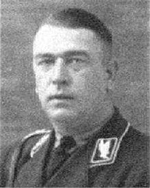 An example is the case of Herbert Fust, left, leader of the SA Group Kurpfalz in Mannheim (and one of the many, many unsung heroes of the Germany National Socialist movement). His group had received one of the orders to “blow up and set on fire all Jewish synagogues” within his region. It was signed by SA Brigade 50 leader Karl Lucke. This report was on hand at Nuremberg. West German courts occupied themselves with this Lucke report from 1946 to 1952. This is what was discovered:
An example is the case of Herbert Fust, left, leader of the SA Group Kurpfalz in Mannheim (and one of the many, many unsung heroes of the Germany National Socialist movement). His group had received one of the orders to “blow up and set on fire all Jewish synagogues” within his region. It was signed by SA Brigade 50 leader Karl Lucke. This report was on hand at Nuremberg. West German courts occupied themselves with this Lucke report from 1946 to 1952. This is what was discovered:
It will be remembered that the Brownshirt Chief of Staff, Victor Lutze, was at the “old comrades” dinner at the old town hall in Munich on the evening of Nov. 9/10, 1938. After Dr. Goebbels had spoken of instances of violence in Hessia and in Magdeburg, Lutze called together the Brownshirt leaders who were present and ordered them to telephone their duty offices at once that Brownshirts “were not to take part in actions against Jews or against Jewish establishments, and to place guards at places where incidents had already taken place, to prevent further damage or looting.” (p. 91)
Herbert Fust was there when Lutze gave his command. Like the others, Fust went to the telephone immediately and relayed the command to his duty office in Mannheim. This was ascertained by a West German court. In a proceeding against Fust, the court stressed specifically that it was convinced that the Brownshirt Chief of Staff (Lutze) had in fact given this command, and that Fust had telephoned that command to his duty office. The court believed him and found him not guilty of the charges of inciting to arson and breach of the peace brought against him.
Naturally, Herbert Fust could not remember, fourteen years later, in 1952, with whom he had spoken that night. But in Mannheim, Fust's command had come in, was written down, acknowledged by telephone—and disappeared. In its place was found the “order for the destruction of the synagogues” cited above. Who in Mannheim accepted the “destruction order” could not be determined. Also, in violation of customary practice, in place of the information about the incoming telephone message, there was found only an annymous piece of paper. Logically, only the man who was on telephone duty that night could be responsible but the West German courts failed to look for that man.
It's true that Brigade leader Lucke could have been more critical of the absurd order to destroy synagogues, but he did not feel up to questioning orders. (Some Brownshirt groups did question it after they had received the same order, and did not follow it.) By the time Lucke was notified about the mistake, it was 3 am and the situation was too far gone to do anything about it.
Weckert concludes that the fact that “orders from higher up” were used as a deception means that logically, in reality, there weren't any “orders from higher up.”
Next installment will be devoted to Weckert's interesting assessment of Cui Bono?, which explains the entire event in light of all the evidence available.
Category
Germany, Historical Revisionism, Jews, Kristallnacht- 1117 reads

